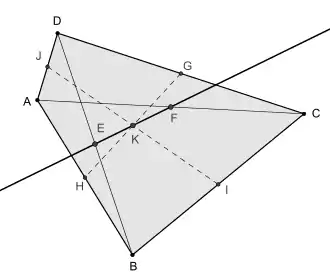Newton line
In Euclidean geometry the Newton line is the line that connects the midpoints of the two diagonals in a convex quadrilateral with at most two parallel sides.[1]

E, K, F lie on a common line, the Newton line
Properties
The line segments GH and IJ that connect the midpoints of opposite sides (the bimedians) of a convex quadrilateral intersect in a point that lies on the Newton line. This point K bisects the line segment EF that connects the diagonal midpoints.[1]
By Anne's theorem and its converse, any interior point P on the Newton line of a quadrilateral ABCD has the property that
where [ABP] denotes the area of triangle ABP.
If the quadrilateral is a tangential quadrilateral, then its incenter also lies on this line.[2]
References
- Claudi Alsina, Roger B. Nelsen: Charming Proofs: A Journey Into Elegant Mathematics. MAA, 2010, ISBN 9780883853481, pp. 108–109 (online copy, p. 108, at Google Books)
- Dušan Djukić, Vladimir Janković, Ivan Matić, Nikola Petrović, The IMO Compendium, Springer, 2006, p. 15.
External links
- Weisstein, Eric W. "Léon Anne's Theorem". MathWorld.
- Alexander Bogomolny: Bimedians in a Quadrilateral at cut-the-knot.org
This article is issued from Wikipedia. The text is licensed under Creative Commons - Attribution - Sharealike. Additional terms may apply for the media files.